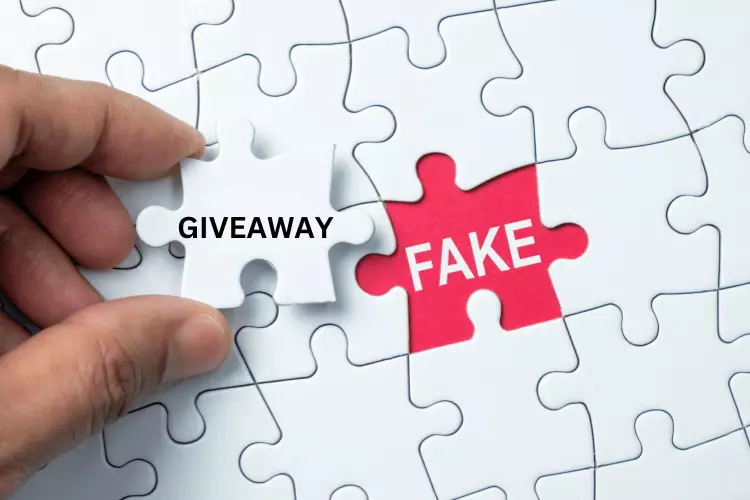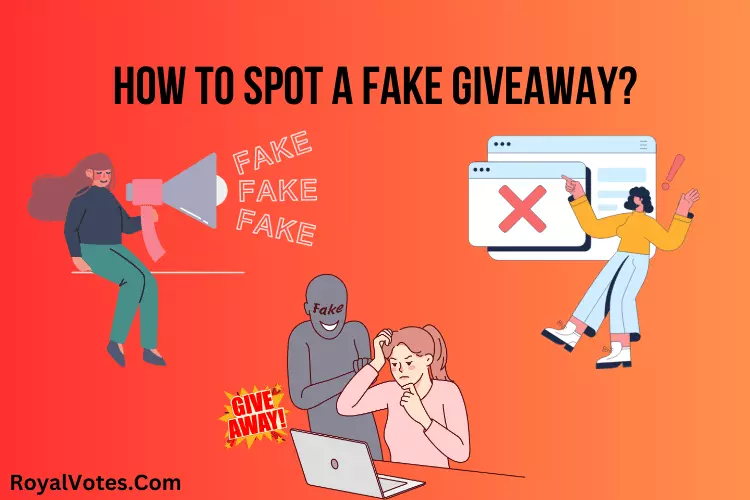Brands often host giveaways as part of their promotional strategy. However, some scammers and fraudsters pretend to be brands and organize fake giveaways. These scammers aim to steal sensitive information from unsuspecting individuals. That’s why users must know how to spot a fake giveaway.
In this blog, I’ll discuss 13 red flags on spotting fake giveaways and how to protect yourself from such scam.

Types of Fake Giveaways
Not all giveaways are the same. Scammers don’t run the same type of giveaway each time to trick you. So, before you identify fake giveaways, you must understand the most common types.
The ‘Too Good to be True’ Giveaway
This is a common form of a fake giveaway, where prizes are excessively extravagant, such as luxury cars, millions of dollars, or all-inclusive trips worldwide. The scammer’s goal here is to entice many people with the promise of a life-changing prize.
For example, suppose a brand is hosting a giveaway for an expensive luxury car like a Ferrari. In that case, it’s highly unlikely that they will give it to everyone who enters the giveaway. This type of scam relies on people getting excited about the possibility of winning something too good to be true.
The Immediate Action Giveaway
Scammers often create a sense of urgency with these fake giveaways, pressuring individuals to participate immediately or lose the chance forever. They might state that the giveaway ends soon or is limited to the first few participants. Authentic giveaways by brands generally allow ample time for people to participate.
The ‘Fee Required’ Giveaway
This type of scam involves the organizer asking for a fee to participate or to receive the prize. They may justify it as a handling fee, tax payment, or shipping fee. Legitimate giveaways rarely, if ever, ask winners to pay anything to receive their prizes.
The Information Harvesting Giveaway
In these scams, the main purpose is to gather sensitive personal information from participants. They might ask for detailed personal data, financial information, or even security questions that can be used to hack into personal accounts. Real giveaways usually only require basic contact information.

How to Spot a Fake Giveaway: 13 Red Flags with Examples
Now you know all the common types of fake giveaways. If you find such promotional ads, there is a high chance they are fake. So, how can you tell if a giveaway is fake? Let’s be more practical.
#1. No Authentic Source
Legitimate giveaways are typically hosted on a brand’s official website or verified social media channels. If the giveaway is conducted on a third-party site or an unverified social media account, it’s a red flag.
For instance, if you come across a giveaway for an iPhone 12 on an Instagram page named ‘Apple_Giveaways_2024’, take a moment to verify the account. Click on the profile and check if it’s a verified account with a blue checkmark. If not, it’s likely a scam.
Additionally, check the content quality and engagement rate. An authentic account would have high-quality content with consistent engagement from its followers. In contrast, scam accounts often have poor-quality content, erratic posting, and low engagement.
Also, be skeptical of email-based giveaways. Always inspect the sender’s email address. Scammers might use an email address that resembles a brand’s name but with slight misspellings or extra characters.
For example, emails from ‘amaz0n@gmail.com’ or ‘support@facebok.com’ are not from Amazon or Facebook, respectively.
#2. No Clear Rules
Every legitimate giveaway should have a clear set of rules and regulations governing participation. These rules typically include eligibility criteria, the duration of the giveaway, how the winner will be selected, and other related details.
For instance, a legitimate giveaway may specify that it is open only to US residents above 18 and will run from January 1 to January 31, 2024. The winner might be chosen through a random February 5, 2024 draw. If a giveaway lacks such detailed rules, it’s likely a scam.
A scam giveaway might vaguely state that it’s open to ‘everyone’ without specifying any geographical or age limitations. Or, it might not provide details on how and when the winner will be selected.
Furthermore, fake giveaways often lack terms and conditions or privacy policies, which are mandatory for any promotional campaign. Legitimate giveaways always respect and protect the privacy of their participants, while fake ones do not.
So, if you come across a giveaway that doesn’t provide clear rules or if the rules seem sketchy and incomplete, be cautious. It might be a scam designed to trick you into providing personal information or money. Always remember, if it doesn’t feel right, it probably isn’t.
#3. Ask So Many Questions
A classic sign of a fake giveaway is when it asks for more information than is necessary for participation. While it’s customary for giveaways to ask for basic data such as your name, email address, or phone number, it’s suspect if they start asking for more in-depth details.
For example, if a giveaway demands your social security number, bank account details, or password-related questions (“What was the name of your first pet?” or “What’s your mother’s maiden name?”), it’s safe to assume it’s a scam.
No legitimate company would ask for such sensitive data in a giveaway, as they are aware of privacy regulations and respect their customers’ security.
In another instance, if a giveaway, purporting to be from a well-known brand such as Nike, asks you to fill out a long survey asking about your shopping habits, shoe preferences, and favorite sports teams, and then progresses to asking for your home address, date of birth, and credit card details – it’s most likely a scam.
While the initial questions might seem relevant to Nike’s industry, the latter queries are red flags. A genuine giveaway would never lead you to reveal such personal or financial data.
#4. Spelling and Grammatical Error
Fake giveaways are riddled with spelling and grammatical errors – something that reputable companies with professional content creators and editors would not make.
For instance, you might find a giveaway on a Facebook page titled ‘Sasung Galaxy S21 Giveaway,’ where ‘Samsung’ is misspelled as ‘Sasung.’ This is a clear red flag indicating a possible scam.
In another instance, you might receive an email claiming to be from your bank, urging you to participate in a giveaway by clicking on a link. If this email is filled with awkward phrasing, grammatical errors, and typos, it’s almost certainly not from a legitimate source.
Reputable organizations maintain high standards in their communications, and such glaring mistakes are unlikely.
Beware of poorly formatted content. It should raise your suspicion if the giveaway details are presented haphazardly, with uneven fonts, incorrect alignment, or inconsistent use of colors.
#5. Unnecessary Hashtag Usage
Excessive or irrelevant hashtag usage can be a telltale sign of a fake giveaway. While it’s common for brands to use relevant hashtags in their social media promotions, spammers often misuse hashtags to reach a wider audience.
For example, a legitimate Apple iPhone giveaway might use hashtags like #Apple, #iPhone, or #Giveaway. But if you come across a giveaway post that contains irrelevant or excessive hashtags such as #FreeMoney, #WinBig, #NoPurchaseNecessary, and #GetRichQuick, it could be a scam.
Another red flag is the use of trending but unrelated hashtags. For example, during the Super Bowl, a fake giveaway might misuse the trending hashtag #SuperBowl to gain visibility, even though the giveaway has nothing to do with the event.
Also, watch out for hashtag stuffing. If a giveaway post includes a long string of hashtags with no spaces or punctuation, it’s likely not genuine.
For example, a post that says, “Win a free iPhone #win #free #iPhone #lucky #money #getrich #sweepstakes #giveaways #nopurchasenecessary #winbig” is probably a scam.
Genuine giveaways use a moderate number of relevant hashtags and maintain readability in their posts.
#6. New or Recently Created Account
A common characteristic of scam giveaways is that they are often conducted through new or recently created social media accounts. This is especially true for counterfeit brand accounts that mimic legitimate companies.
For instance, a Facebook page titled ‘Apple Giveaways’ was created only a few weeks ago and has little or no content apart from the giveaway post, which should raise your suspicion. Likewise, if an Instagram account purporting to be a popular brand has few followers, no profile picture, or only one or two posts, it’s likely a scam.
Authentic businesses, especially large corporations, have well-established social media presence with many posts, followers, and engagements over a significant period. Always verify the authenticity of the account before participating in any giveaways.
#7. Fake Engagements
Scam giveaways often show abnormal engagement metrics that don’t align with the number of followers or typical activity level of the hosting profile. Look out for many likes or shares compared to the account’s obscurity, which suggests fake engagements.
For example, if a newly created account with only 10 followers claims to give away a brand-new Tesla car and receives thousands of likes within hours, those engagements are likely not genuine.
Be cautious of profiles with sudden, unexplained spikes in follower count, as this could indicate the use of bot followers to create an illusion of popularity. If an Instagram page had 500 followers last week and now has 20,000 without significant content or activity changes, it’s a red flag.
Pay attention to the quality of comments under the giveaway post. Generic comments like “Great!” or “Awesome!” might be automated responses from bots. Also, repeated comments from the same profiles suggest fake accounts.
#8. Low-Quality Visuals
Low-quality visuals in a giveaway post can indicate a scam. Reputable brands invest in professional photography or high-quality designs to represent their products and services, reinforcing their brand image. Poorly designed content, pixelated images, or visuals lifted from search engine results are red flags.
For example, if a giveaway for a new MacBook has a blurry image or a distorted Apple logo, it’s likely not legitimate. Authentic giveaways feature high-resolution, professionally shot images.
Be cautious of posts with inconsistent visuals or discrepancies between images and giveaway details. Genuine giveaways pay attention to detail, ensuring images and text-align perfectly.
#9. No Mention of Prizes in Detail
Sometimes, fake giveaways lack detailed information about the prizes. Legitimate contests, on the other hand, provide all the specifics – model numbers, colors, sizes, you name it.
For example, a real giveaway for an iPhone 12 would say something like, “Enter to win an iPhone 12 Pro Max in Pacific Blue with 256GB storage.” No ambiguity there!
Beware of fake giveaways saying, “Win a free phone!” without mentioning the brand or model. That vagueness is a red flag – it means there might not be a real prize at all. And watch out for those giveaways that promise ridiculously huge prizes.
If a little-known brand claims to give away a free house or a luxury car, it’s probably too good to be true.
#10. Pressure Tactics
Scammers often employ pressure tactics to create a sense of urgency, making you act impulsively rather than rationalizing your decision. They may insist that their giveaway is a “limited-time offer” or the “last chance” to win something. This rush is a strategy to prevent you from thoroughly investigating the giveaway’s legitimacy.
For instance, you might come across an Instagram post with captions like “Hurry! Only the first 1000 people to comment will win!” or “Last chance to enter! The giveaway ends in the next hour!” These pressure tactics are designed to provoke instant actions, making users overlook potential scam indicators.
In another example, an email might claim you’ve won a giveaway you don’t remember entering but that you must act immediately to claim your prize. The email might state, “Click this link within the next hour to claim your prize, or it will be passed on to the next winner!” These are clear pressure tactics that should raise your suspicion levels.
Another common method is to claim that you’ve won an incredible prize (like an expensive car or a large sum of money) but require you to pay a small fee or provide personal information to claim it. They may say, “You’ve won a brand new iPhone! Click this link to pay a small delivery fee and claim it.”
Fake giveaways can use pressure tactics in many ways to rush participants into decisions, so stay vigilant and think critically before participating.
#11. Non-responsive Host
A non-responsive host is a strong indicator of a fake giveaway. Legitimate giveaways are usually conducted by businesses or influencers who value their audience and maintain open lines of communication. If the host of a giveaway is not responding to comments, queries, or direct messages, take it as a red flag.
For example, you might come across a giveaway post on Instagram from an account that claims to be a popular brand. If you have doubts and decide to leave a comment asking for more information or verification, a genuine host would likely respond to your query publicly or through a direct message. However, if your comment remains unanswered or, worse, deleted, it is a strong indicator of a scam.
Similarly, if you have sent a direct message to the giveaway host asking about the terms and conditions, and your message is ignored, it suggests that the host may not be genuine.
Authentic giveaway hosts are usually transparent about their rules and actively engage with their audience. They are eager to clarify doubts and ensure all participants have a positive, fair experience.
Observing the host’s interaction with the audience is always a good practice. If there seems to be a pattern of non-responsiveness or dismissive attitudes, it’s advisable to steer clear of such giveaways.
#12. “Increase the Chance of Win by an Action” – Such Statements
Another common way of distinguishing a fake giveaway from a legitimate one is to look for statements that claim you can increase your chances of winning by carrying out a certain action, especially when that action benefits the host.
For example, a host may say, “Share this post and tag three friends to double your chances of winning.” While this could indeed be part of a legitimate promotional strategy, it could also be a tactic employed by scammers to gain wider visibility.
In another instance, a host might claim that purchasing their product will increase your odds of winning. For instance, “Buy our new range of skincare products and triple your chances of winning this giveaway.” This could simply be a ploy to boost sales under the guise of a giveaway.
Legitimate contests might offer extra entries for certain actions, but they seldom tie it to purchase or make grandiose claims about drastically improving your odds.
Read also: How to win a giveaway?
#13. Unusual Payment Requests
Fake giveaways often involve suspicious payment requests, like asking for a fee to claim a prize or requesting financial details for verification. These tactics are common among scammers who aim to take your money or steal your information.
For instance, an email might say, “Congratulations! You’ve won a trip to the Bahamas! Just pay a small fee of $50 to claim your prize!” Legitimate contests don’t require winners to pay. This is a clear scam.
Similarly, a text message might claim you’ve won a cash prize, but they need your account and routing numbers to transfer the money. Providing this information puts your account at risk.
Also, beware of payment requests that demand untraceable methods like wire transfers, gift cards, or cryptocurrencies. Reputable companies don’t require unconventional payment methods.
Check out the below video content on – How to Tell Which iPhone Giveaways are “FAKE” or “REAL”?
Why Scammers Host Fake Giveaways?
Now, you may wonder why scammers go through the trouble of hosting fake giveaways. What is their end goal?
#1. To Gain Visibility and Followers
Scammers host fake giveaways to rapidly increase their visibility and gain followers on social media platforms. A post promising an attractive prize for liking, sharing, and tagging friends can quickly go viral, bringing a flood of engagement to the scammer’s page.
For example, a fake account may promise a high-value item like a gaming console or designer handbag, attracting many users who follow, like, and share the post in hopes of winning.
#2. To Harvest Personal Information
Another common reason for hosting fake giveaways is to harvest personal information from entrants, which can be sold or used for fraud.
For instance, a scammer may host a “giveaway” that requires users to fill out a detailed form to enter, collecting information such as their full name, address, phone number, and email address. This information can be used for identity theft or sold on the dark web.
#3. To Drive Sales or Traffic
Scammers may also use fake giveaways to drive website sales or traffic. They may ask participants to purchase or visit certain pages on their site to increase their “chances of winning.” This results in increased sales or ad revenue for the scammer and boosts their search engine ranking with the influx of traffic.
#4. To Collect Payment or Financial Information
Some scammers host fake giveaways to steal money directly from participants. They may ask winners to pay a “delivery fee” or “tax” to claim their prize or ask for bank details to “transfer the prize money.” This enables them to steal money directly from the victims’ bank accounts.
#5. To Promote Malware or Phishing Attacks
Scammers may use fake giveaways to distribute malware or execute phishing attacks. They may ask participants to click on a link to claim their prize, which leads to a malicious website that installs malware on their device or steals their login credentials.
For instance, a scammer may email stating that you’ve won a prize and ask you to click on a link to claim it. The link then leads to a phishing site that looks like a legitimate login page, tricking you into entering your credentials which the scammer can then use for unauthorized access.
Always be vigilant and do your due diligence before participating in online giveaways. If something seems too good to be true, it probably is.
Read also: Do people actually win sweepstakes?
How Do You Protect Yourself from Fake Giveaways?
Here are some tips for you to protect yourself from fake giveaways.
#1. Verify the Source
Before participating in any online giveaway, verifying the source is important. Check the account that posted the giveaway. Is it a well-known brand or influencer? Does the account have many followers and a regular, relevant content history?
It might be a scam if the account is recently created, lacks content, or has few followers.
#2. Read the Terms and Conditions
Always read the terms and conditions of the giveaway. A legitimate giveaway will clearly outline the rules, eligibility criteria, prize details, and how the winner will be selected and notified. If these details are missing or vague, it’s a red flag.
#3. Be Wary of Urgency
Scammers often create a sense of urgency to prevent you from thinking critically about the giveaway. If an offer demands immediate action or has a very short timeframe, take a moment to consider its legitimacy before participating.
#4. Protect Your Personal Information
Never give out more personal information than necessary. While it’s common for legitimate giveaways to ask for your name and email address, be wary of contests asking for sensitive information like your Social Security number, bank account details, or other financial data.
#5. Beware of Unsolicited Winner Notifications
If you receive a notification claiming you’ve won a contest you don’t remember entering, it’s likely a scam. Never click on links or download attachments from unsolicited emails or messages.
#6. Use Secure, Updated Devices
Ensure your computer or mobile device is secure and up-to-date with the latest security patches and antivirus software. This can help protect you from malware and phishing attacks associated with fake giveaways.
#7. Report Suspicious Giveaways
If you come across a giveaway that seems suspicious, report it. Most social media platforms have mechanisms in place for reporting scams, and your report can help protect others from falling victim.
Conclusion
Now, you have a detailed understanding of identifying a fake giveaway. Remember to always verify the authenticity of a giveaway before participating, and never share sensitive information or make payments.
By following these guidelines, you can protect yourself from falling victim to scams and enjoy legitimate giveaways without any worries! Watch for the signs mentioned above, and stay safe online.


